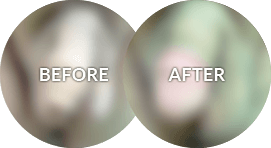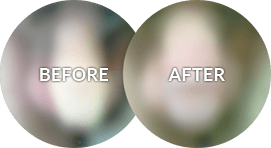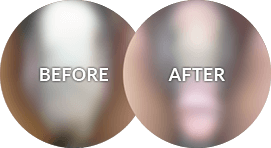An unexpected growth on the penis is an unnerving sight for any man. More than one growth may even ring alarm bells. But oftentimes, what we may perceive to be a sexually-transmitted disease (STD), such genital warts, is actually something completely benign and natural, like pearly penile papules (PPP).
Though researchers have found it difficult to study how many men have them, it is thought that between 14-48% of men have them. (1) So when is it PPP, and when is it an STD? Understandably, anything unusual in the genital area comes with its own concerns and anxieties. Regardless of the condition, the next step for most patients is to seek out an expert evaluation by a urologist.
Dr. Mo Bidair is a leading San Diego urologist at Alvarado La Mesa Urology Center. He specializes in adult circumcision and the medical or cosmetic treatment of men’s health concerns. To book a private consultation, call (619) 486-5005 or make an inquiry using our online form.
Contents
Pearly Penile Papules
PPPs are harmless, dome-shaped growths around the coronal ridge of the penis, the area that surrounds the glans (head). They usually appear in adolescence and adulthood, and are more common after circumcision. (1)
PPP Characteristics
- Whitish-pink to yellow in color
- Benign (non-cancerous)
- Small, raised, and round
- “Pearly” sheen
- Located around the corona
PPP size ranges from 1 mm (0.039 in) to 4 mm (0.16 in). Some men may have many smaller papules, while others may have several uniformly large papules. It depends entirely on the person! When present, they may appear in one, or many, rows toward the sides of the glans. They may also be found in smaller numbers on the shaft of the penis. (1)
PPP Size
Many men cannot easily tell what PPPs are, or how to distinguish them from other lesions, and that is nothing to be ashamed of! However, urologists have recorded something of a trend when it comes to diagnosis. In fact, most frequently, men will see a urologist if their papules are larger in size, rather than smaller.
Research reveals that 66% of males with moderate-to-large pearly penile papules had concerns, while the remaining 34% were not worried about them. (1)
More about Pearly Penile Papules.
Do I Have an STD?
Ruling out PPP, the presence of an STD is a possibility. Four of the eight most common STDs are treatable and curable. (2)
- Chlamydia – No papules, burning during urination, discharge.
- Gonorrhea – Unusual sores/rash, burning during urination, discharge.
- Syphilis – Painless ulcers/sores, swollen lymph nodes, fever, fatigue, headache.
- Trichomoniasis – No papules, redness/soreness for women, often symptomless for men.
Four STDs are treatable but currently have no cure. (2)
- Hepatitis B – No papules, may present in many ways, fever, fatigue, nausea, dark urine.
- Herpes Simplex Virus (HSV) – Painful/itchy sores, discharge, painful urination, fatigue.
- Human Papillomavirus (HPV) – May be symptomless, genital warts, unusual growths, sores.
- HIV – Various flu-like symptoms, extreme fatigue, fever, muscle aches, night sweats.
When to Get Checked
If you suspect you have an STD, stop having sex and get tested to confirm or disprove your suspicions, and do not resume sexual contact until you have your results and have been counseled by a medical professional. Book a consultation with Dr. Bidair if you suspect you have pearly penile papules and are interested in removing them.
Genital Warts & HPV
HPV is the most common STD in the US and worldwide. (3) To put that into perspective, according to the CDC, 2 in 5 (40%) of 15- to 59-year-old men and women will have HPV. (4) HPV is associated with the development of genital warts in some people.
There are over 60 variants of HPV, and only a small fraction of these have serious symptoms. However, most importantly, despite being asymptomatic, a person can still pass the HPV virus on to a sexual partner.
HPV risk Factors(5)
- Presence of foreskin
- Many sexual partners
- Lack of condom use
- Smoking
HSV vs. HPV
Most cases of genital ulcers are caused by herpes simplex virus. (3) HSV, can present as painful blisters on the mouth (cold sores) or painful ulcerative lesions on the genitals. However, unlike genital warts, the symptoms can be far more pronounced, particularly in terms of discomfort, for some people. Antiviral medications like valacyclovir (Valtrex) may be prescribed to prevent sores, however, this does not prevent transmission of the virus.
Medical terminology can be confusing, especially if conditions sound similar when they are abbreviated. In short, HPV is the known cause of genital warts, and HSV types 1 & 2 are responsible for herpes.
Find out more about lowering the risk of STDs including reducing the risk of HPV transmission on our blog.
Common Lumps & Bumps Requiring Treatment
If you have ruled out PPPs and the most common sexually-transmitted infections, there may be another reason why you have an unexpected growth on the penis.
- Folliculitis – Inflammation of the hair follicles usually appear at the base of the penis, but may occur further along the shaft.
- Molluscum Contagiosum – A painless STI that causes small bumps from skin-to-skin contact.
- Peyronie’s Disease – Fibrous scar tissue that can cause curved, painful erections.
Appointment with a Urologist
Seeing a urologist for any reason is an important step for a man to take full control of his health. Dr. Bidair will assess any issues you have with your urological health, and help you to understand what’s going on “down there”. In a one-on-one consultation, Dr. Bidair will inquire about your reason for arranging the appointment. Once you have explained your situation briefly, he will conduct an examination of the genital area. Discreet, professional medical treatment is of paramount importance, so please feel free to be frank about your concerns!
Book an individual consultation with San Diego’s leading urologist Dr. Mo Bidair by calling
PPP Removal
If you are relieved to find out that the unknown growths on your penis were merely harmless pearly penile papules, you may be wondering what the next steps are in terms of your treatment. For many men, the condition will not be a concern and no further action needs to be taken. However, if you are dissatisfied with the appearance of PPPs, or if you are embarrassed about them in front of their partner, help is at hand in the form of cosmetic Pearly Penile Papule Removal.
How Does PPP Removal Work?
PPP removal can be conducted in several ways. Dr. Bidair prefers laser treatment to remove them once and for all.
- Conducted under local anesthesia for your comfort
- Accurately targets and removes papules
- Achieves smoother, papule-free skin
- Very short, straightforward procedure
PPP removal is an incredibly simple in-office procedure. To discuss this and other urological concerns, contact us for a consultation at Alvarado La Mesa Urology Center.
Cost of Penis Growth Treatment in San Diego
Finding an experienced urologist in Southern California is the key to your sexual health and wellbeing. As every patient’s needs vary, the cost of your treatment will be calculated after your personal consultation. Receive a thorough evaluation of your issues with Dr. Bidair. Call (619) 486-5005 to arrange your private consultation at our La Mesa location.
Find out more about the benefits of Adult Circumcision and see Dr. Bidair’s outstanding circumcision and revision circumcision Results!
FAQ
What are the spots on my penis?
There are a number of conditions that cause unknown growths and lumps on the penis. These include sexually-transmitted infections which require treatment, or harmless, natural pearly penile papules. The only way to know for sure what they are is to speak to a urologist or men’s health specialist.
Is it normal for a circumcised penis to have bumps?
If the bumps are pearly penile papules (PPPs), yes! PPPs are small, benign growths on the coronal ridge of the penis, the area directly behind the head. Seek a medical assessment for a full evaluation if you have any new or unusual penile growths.
Are pearly penile papules present at birth?
No, there are very few recorded instances of PPPs until adolescence.
Will I get PPPs if I get circumcised?
Although PPPs are more common in circumcised men, this doesn’t mean you will develop them after adult circumcision. If they do develop, they are completely harmless, and may even be removed in a simple cosmetic procedure.
References
- Badri T, Ramsey ML. Pearly Penile Papule. PubMed. Published 2020. https://www.ncbi.nlm.nih.gov/books/NBK442028/
- Garcia MR, Leslie SW, Wray AA. Sexually Transmitted Infections. PubMed. Published 2022. Accessed February 1, 2023. https://www.ncbi.nlm.nih.gov/books/NBK560808/#:~:text=The%20most%20common%20STI%20in
- Chipollini J, De la Rosa AH, Azizi M, Shayegan B, Zorn KC, Spiess PE. Patient presentation, differential diagnosis, and management of penile lesions. Canadian Urological Association journal = Journal de l’Association des urologues du Canada. 2019;13(2 Suppl 1):S2-S8. doi:10.5489/cuaj.5712
- Centers for Disease Control and Prevention. STD Facts – HPV and Men. cdc.gov. Published 2019. https://www.cdc.gov/std/hpv/stdfact-hpv-and-men.htm
- Leslie SW, Sajjad H, Kumar S. Genital Warts. PubMed. Published 2020. https://www.ncbi.nlm.nih.gov/books/NBK441884/





